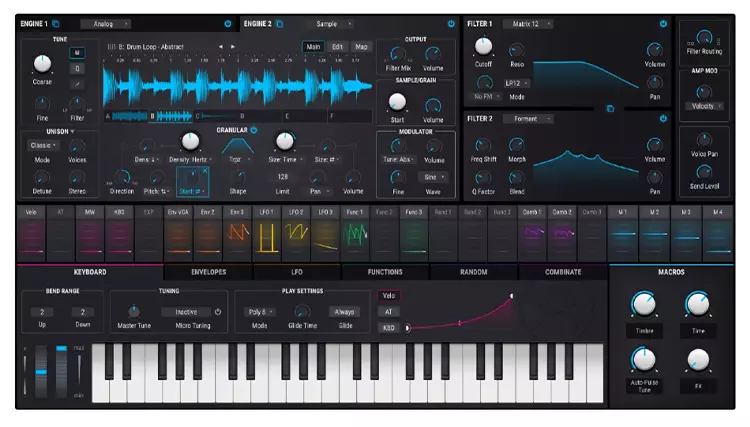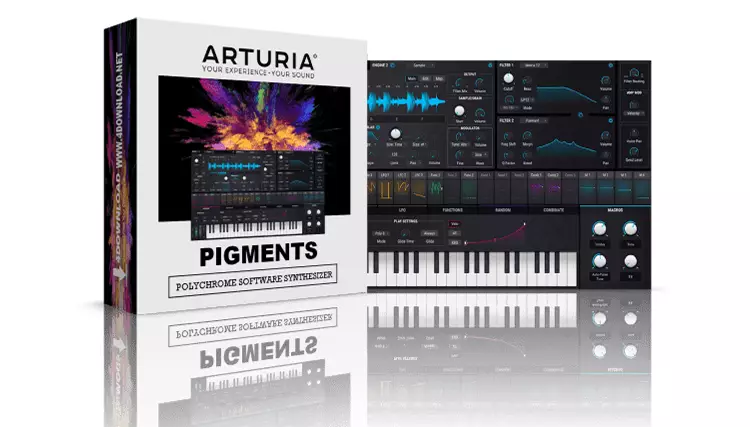Last Updated on December 22, 2020 by IDS Team
The ‘arms race’ for the best VST instruments, samplers, sequencers, digital synthesizers, wavetables, granular instruments, and software has not yet been concluded, and the tides have dramatically turned with the coming of Arturia’s Pigments, which basically wrapped the elements of all the aforementioned goodies in a neat, convenient little package.
Basically, Arturia’s Pigments is a top-shelf Polychrome Software Synthesizer that offers an abundance of highly versatile features tailored to cater to the needs of music producers, musicians, DJs, and pretty much everyone who’s even remotely into music composition.
In short words, it’s a program comprised of virtual instruments, sequencers, samplers, EQ stages, and a plethora of functionalities that are as unique as they are practical.
Today we’re diving into the Pigments’ specs and features, so stick with us for a while longer if you’re searching for the ultimate compositional software piece on the market.
Design and Interface
One of the first things that you’ll hear about Arturia’s Pigments is that it’s a program with a ridiculous amount of features.
Now, before that dissuades you from trying it out, we should point out that it possesses an incredibly intuitive, beginner-friendly interface.
The main screen of the Pigments is chopped up into smaller logical fragments, which are both intelligently connected and highly discernable from one another.
Each part features different kinds of colors, graphics, and visuals that will help you set them apart from very early on.
Engine and Filter section

The Engine and Filter sections are located in the upper-most corners of the interface. These parts take up the bulk of the display, but all of the features contained therein are self-explanatory and relatively easy to use.
The upper sections of the Pigments offer simplified filters, equalizers, and modulator controls. Here is where you will get to mix individual instruments, play them together or atop of one another, modulate separate sections of your tunes, and master the basic settings, such as volume, frequencies, and similar parameters.
Waveform macros
The tiniest section of this software is essentially the Waveform Macro part; this is where you’ll filter your creative juices in, as this is the part that basically alters and shifts whichever notes you’ve programmed with the built-in keyboard.
The macros are colored differently, and you can pick a preset, shape your own, activate the ‘random’ function to generate brand-new ones, and even combine several for relatively unpredictable results.
Keyboard
The integrated keyboard is pretty basic; it features only four octaves, and it’s precisely its minimalistic design that appeals to beginners the most.
Of course, you’ll be able to move along the octaves with the little slider buttons on the left side of the piano, as well as regulate its volume (which does not affect the ‘master’ volume; it’s purely a feature for your own convenience and comfort).
The keyboard section has a couple of functions; it features the ‘bend range’, which basically governs the octaves; the ‘tuning’ is self-explanatory and very convenient, especially if you wish to tweak and spice up pre-recorded songs; and lastly, we have the ‘play settings’, which offer a couple of exquisite features, including the glide time, and ‘mode selector’ knob.
Who is Arturia Pigments perfect for?
In a nutshell, this is an incredibly versatile program that is as useful in the hands of professional studio producers as it is in the hands of beginner musicians and DJs.
It’s laden with a plethora of functionalities, which may appear a bit overwhelming at times, but essentially it’s not that difficult to use.
We could go as far as to define the Pigments as‘scaling’ software; this is a program that evolves as you begin to master it, opening new doors to your creativity.
Most of the features it comes supplied with are limited only by the bounds of your creative genius.
Pros:
- One of the most versatile music-production programs on the market
- Limitless wave-shaping potential
- A bundle of highly intuitive features
- Packed with top-quality presets and sequencers
- Simplistic mixing and mastering features
- Ideal for both professionals and neophyte producers and DJs
Cons:
- The sections can’t be customized
- Can appear intimidating for newcomers and beginners at first
Pigments 2 – newer, a bit more expensive version
The Pigments 2 is the brand-new, upgraded, re-polished version of Arturia’s original Pigments PSS that brings a huge array of new features and benefits to the table.
Obviously, it’s slightly more expensive than the original, and it’s just slightly harder to use due to an increased number of selectable and customizable settings.
The first improvement is the brand-new sample engine; it features a redesigned interface and a couple of tweaks regarding the playback/load tracks.
The second most notable addition to the Pigments 2 is the additional Synth Mode; essentially, this function is comprised of additional digital knobs and wheels that will provide you with even more eclectic opportunities to shape and reconfigure your tones and effects.
Furthermore, there’s another Sequencer aboard the Pigments 2; this is essentially an integrated feature that allows you to rearrange chunks, bits, and pieces of your sounds, track sections, and fragments in whichever order you want.
Last, but not least, we should also mention that the Pigments 2 comes equipped with a variety of new features, such as the new interface, the re-imagined undo and redo buttons, advanced modulation bars, MPE capability, as well as with a selection of additional presets.
While Arturia’s Pigments (1) is fairly beginner-friendly, Pigments 2 is better suited for seasoned producers and DJs.
Conclusion
Arturia’s Pigments brings so many benefits to the table that it’s pretty fair to say it’s worth every single cent of the price.
It’s one of the most eclectic, most versatile tools a musician can have, especially if you’re feeling like you’re lacking creative outlets.
Pigments sports elements of virtual instruments, digital percussions, mixing consoles, equalizers, sequencers, and many other convenient programs that you would otherwise have to obtain elsewhere, but in this case, they’re stacked together in a convenient, easy-to-use package.



